
|
2024 marked the 76th edition of Bonneville Speed Week, which was held from August 3 to 9 at the Salts Flats in Wendover, Utah.
Vehicles racing at the Salt Flats compete in one of seven broad categories depending on their construction and the technology employed.
Within each category are a number of classes.
- Special Construction Category: This represents vehicles competing within the quickest classes.
These are hand-constructed vehicles, not modified production cars.
Streamliners (covered-wheels) and Lakesters (open wheels) are in this class.
Modes of power in these classes are gasoline, diesel, electric and turbine engines.
- Vintage Category: This category is for cars produced before 1948.
- Classic Category: This category is restricted to coupes and sedans produced between 1928 and 1981.
Minimal modifications are allowed to the bodywork, and engine management systems are limited to OEM designs.
- Modified Category: This category includes domestic and foreign coupes and sedans.
These vehicles have been modified so that they do not meet the rules of other categories.
- Production Category: Vehicles in this category have a very limited number of modifications.
It includes – production-based coupes, sedans, grand touring sports cars and pickups with different induction systems.
- Diesel Truck Category: This is a catchall for diesel trucks constructed with varying degrees of technology.
- Motorcycle Category: This category includes production, modified, special construction, streamliner and sidecar classes.
Within each category, there are a number of classes, and speed records are set for classes.
Classes are determined by attributes such as engine displacement, fuel type, induction system, body style and modifications, etc.
After a rainout in 2022 and a shortened course last year due to rain before the event, 2024 was expected to produce many new records.
Despite record temperatures of over 100F on some days, nearly 350 competitors entered, and a large number of them contributed to over 100 of the new land speed records.
|
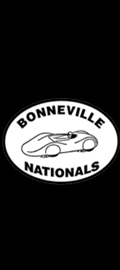
|
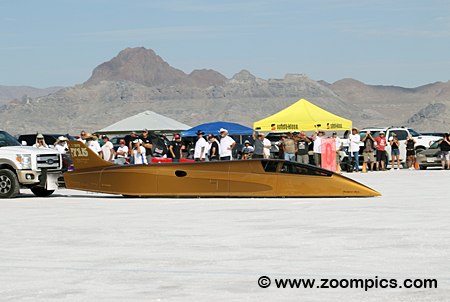
|
George Poteet, driver of the Speed Demon from 2007 to 2021, passed away less than a month before this year's Speed Week event.
Poteet set thirteen SCTA and six FIA records.
He has run over 400 mph more than fifty times.
Chris Raschke was given the honour of driving Speed Demon in 2023.
This year, Raschke set a new B/BFS record of 446.716 mph.
As his predecessor had accomplished eleven times, Raschke earned the Hot Rod Magazine Trophy for the fastest speed at the event.
|

|
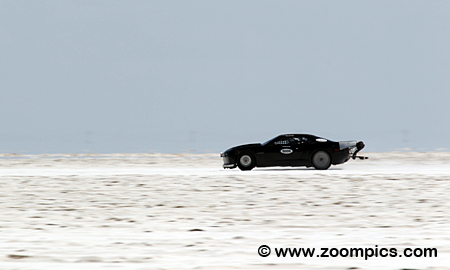
|
It is wise for spectators to bring binoculars as the viewing area is approximately a quarter mile from the track.
On the long course is owner/driver Michael Segorski in the No. 9006 2014 Chevrolet Camaro ZL1 powered by a 572 cu.in. Chevrolet V8 engine.
He competed in the AA / BGALT category of the Blown Gas Altered Coupe division. The record for this class was set in 2021 at 286.780 mph.
Segorski's best run at the event was 181.303 mph.
|

|
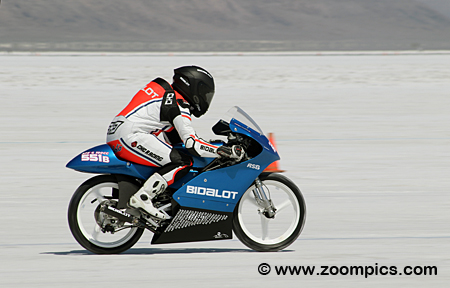
|
There were plenty of motorcycles competing at this year's Speed Week.
In fact, over thirty speed records were set across fifteen different motorcycle divisions.
The Bidalot Expresso is a French effort owned by Arnaud Bidalot.
Bidalot Technologies was founded in 1988 and has 102 French championships.
They entered one of their latest creations in the 100cc APS-F class.
The team's rider, Arnaud Senegon, set a new record at 105.895 mph.
|

|
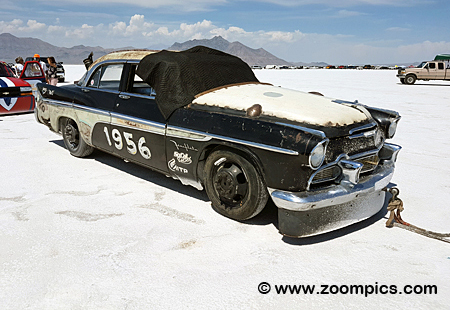
|
Some entries took advantage of the expansive Bonneville Salt Flats and Southern California Timing Association resources to experience their vehicle's performance.
These teams registered in the Time Only (T/O) category.
One such car was the Desotomaxx. The Desotomaxx started life as a 1956 Desoto Fireflite, which is currently powered by a 6.6-liter V8 Duramax from a 2003 Chevrolet Silverado.
The team researched a top speed of 176.523 mph.
|

|
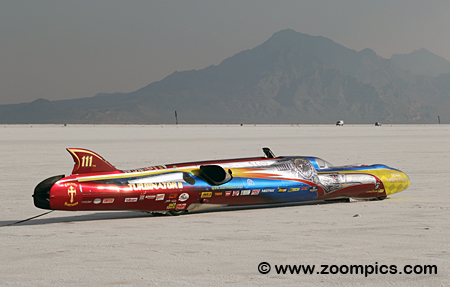
|
In 2018, Team Vesco got their Turbinator II to reach a speed of 503.332 mph.
Unfortunately, the team could not back up the speed, which meant it was not a record run.
The thirty-six-foot-long Turbinator II is powered by a Lycoming-built Chinook helicopter engine with an output of over 5,000 horsepower.
With that much power, the team's challenge is not spinning the wheels.
The Turbinator II was driven by Dave Spangler, who managed a speed of 214.570 mph at the event.
|

|
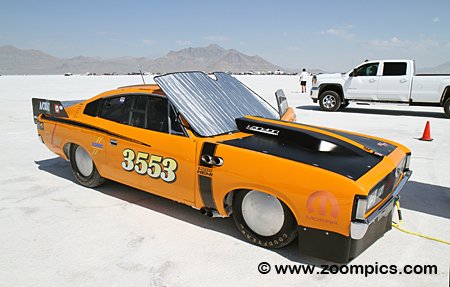
|
G.S.D. Racing from New Zealand entered this 1972 Chrysler Valiant Charger.
The Valiant Charger line was introduced by Chrysler Australia in 1971. The car was available with several different options.
The Charger 770 SE was equipped with a 340 cu.in. four-barrel carburetor V8. Hemi V8.
The G.S.D. Racing Valiant was fitted with a 495 cu.in. Hemi V8 and competed in the A/CBFALT category.
Although not a record, their fastest speed was 251.628 mph.
|

|
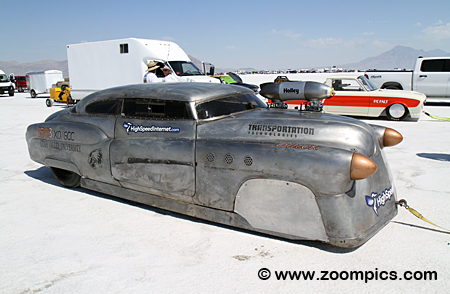
|
Bombshell Betty came off the assembly line as a 1952 Buick Special Rivera.
The original two-door hardtop coupe was equipped with a 263.3 cu.in. inline eight-cylinder motor producing 120 horsepower.
The 3,665-pound car would travel down the quarter mile in 20.7 seconds.
Bombshell Betty uses a 324 cu.in. inline eight-cylinder and competes in the XO/GCC category.
The class record is 175.031; unfortunately, their best speed was 148.062 mph.
|

|
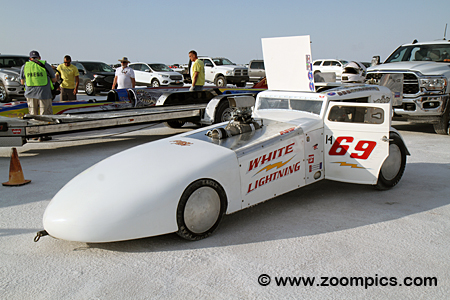
|
White Lightning is based on a 1933 Austin America Coupe. The car, produced from 1930-34, is an American version of the Austin 7.
The tiny car was powered by a 45.6 cu.in. four-cylinder engine that produced thirteen horsepower.
White Lightning is equipped with a 1932 213 cu.in. Ford flathead V8 motor.
The car competes in the Vintage Blown Fuel Competition Coupe group.
Driver and owner Bill Lattin reached a top speed of 126.456 mph.
|

|
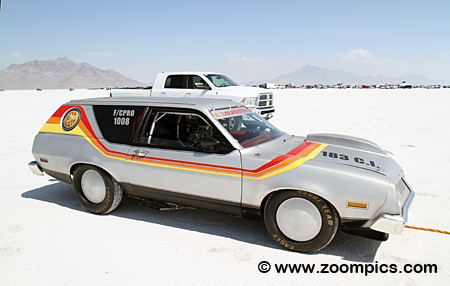
|
Another unusual vehicle at this year's Speed Week is this 1978 Ford Pinto Cruising Wagon.
The Cruising Wagon option included a front spoiler, glass portholes, special wheels, and Sports Rallye equipment.
It was available with a 2.3-liter four-cylinder or 2.8-liter V6. The Land Speed Pinto entry uses the 2.3-liter and competes in the F/CPRO category.
The team was trying to exceed a speed of 151.670 mph but could only manage 132.612 mph.
|

|
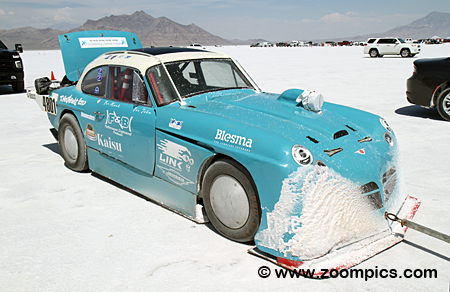
|
Jensen Motors was founded by brothers Alan and Richard Jensen in 1922.
The company ceased operations in 2011 but produced some interesting cars, such as the Jenson Interceptor and Jensen-Healey.
F & B Jensen Racing entered a much modified 1965 Jensen C-V8 in the A/BGCC class.
The F & B Jensen Racing C-V8 is equipped with a 496 cu.in. Chrysler.
The class record is 258.378 mph, but the team fell short with a speed of 174.783 mph.
|

|
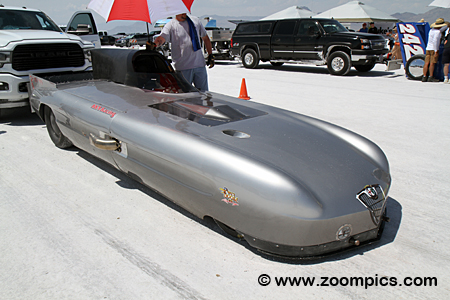
|
The KKM / WGB Racing entry is based on a 1976 Alfa Romeo Spider.
The original four-cylinder double overhead camshaft engine has been replaced with a Toyota 2JZ.
The 2JZ is a six-cylinder, 3.0-liter motor produced by Toyota from 1991 to 2007.
In 1995, the company introduced variable valve timing.
The Alfa was driven by Gerard Collier and the owner, Lee Kennedy.
They were chasing the F / BFMS record of 200.626 mph. Their best was 217.501 mph.
|

|
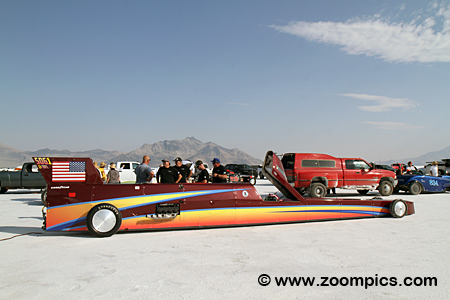
|
At this year's Speed Week, Anita Strasburg became the fastest woman on the salt.
Strasburg drove the 2012 Mel Swain Lakester powered by a 303 BAE motor.
Her first challenge was to eclipse the D/BFL record, which was 332.531 mph, set in 2020 by DRM Racing.
Strasburg did just that, achieving a speed of 341.972 mph.
Then, the team switched the engine with the goal of exceeding the previous best speed in B/BFL.
She set a new record at 375.859 mph.
|

|
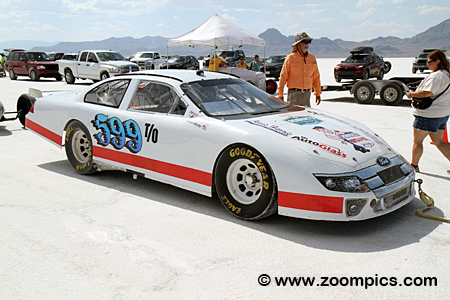
|
Another Time Only (T/O) entry was the Lewis Harris — Billy Roberts Racing 2011 Ford Fusion.
The Ford is constructed to NASCAR rules by Roush Racing.
Like most stock car series, the chassis is a steel tube frame design covered with a fiberglass body.
Despite being entered as a Ford Fusion, it uses a 350 cu.in. Chevrolet engine.
Owners and drivers Harris and Roberts recorded a top speed of 151.964 mph during the event.
|

|

|
Competing in the B/GC class of the Unblown Gas Coupe division was Oechsner Motorsports.
The owners and drivers, Glen and Aaron Oechsner, entered a second-generation 1966 Chevrolet Corvair.
The Corvair was a successful model for G M until Ralph Nader released his book Unsafe at Any Speed.’ This model year came with a 2.7-liter flat six-cylinder engine.
However, the Oechsner team used a 416 cu.in. V8. The car’s best speed during the week was 134.393 mph.
|

|
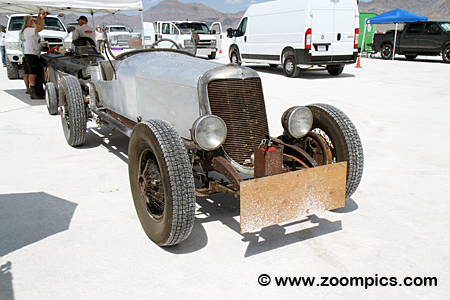
|
This push/tow vehicle was created using parts the owner had collected over many years at swap meets.
The chassis is from a 1929 Studebaker President, a luxury vehicle produced by Studebaker from 1926 to 1942.
The headlights are from an International truck, and the grille is from a 1933 Desoto.
This vehicle is powered by a Dodge 50 truck engine.
The motor is an inline six-cylinder with a flathead. The final product is covered by an aluminum body.
|

|
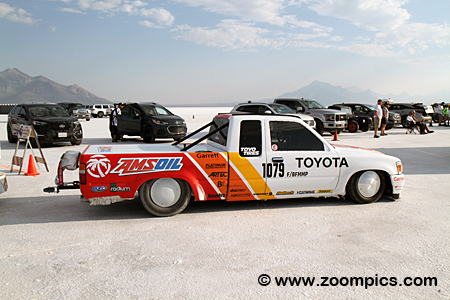
|
Scott Birdsall brought a fifth-generation 1993 Toyota Hi-Lux to this year’s edition of Speed Week.
The fifth-generation Hi-Lux was produced from 1988 to 1997. While a 3.0-liter engine option is available, the team chose the 2JZ motor.
The 2JZ is an inline six-cylinder twin-turbocharged motor used in the Supra model.
Without engine upgrades, it produces 321 horsepower.
Birdsall competed in F / BFMMP and set a new record of 229.541 mph. The previous record was 189.460 mph.
|

|
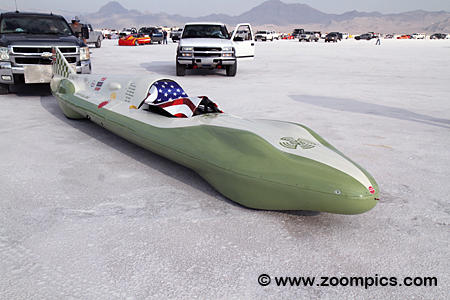
|
Mursick Motorsports entered this 2020 Vesco/Mursick in the H/DS class of the Diesel Streamliner division.
The Streamliner gets its power from a 1.5-liter four-cylinder diesel Volkswagen engine.
Driver / Owner Chris Mursick was attempting to better the record set in 2009 of 123.605 mph.
By the end of the event, Mursick had reached a top speed of 125.968 mph.
However, his competition, Robert Savarino, set a new class record of 136.283 mph.
|

|
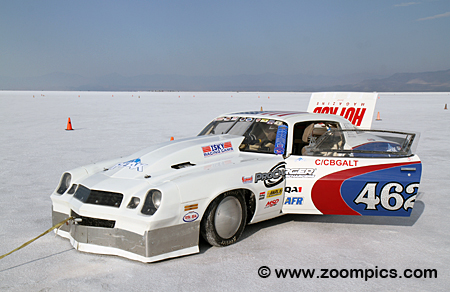
|
The co-host of Hot Rod Garage, Alex Taylor, was on a mission at this year’s Speed Week.
Her objective was to set a record and join the 200-mph Club.
Taylor was entered in Keith and Tonya Turk’s 1980 Chevrolet Camaro, powered by a 364 cu.in. Chevrolet small block engine.
She competed in the C/CBGALT class and went 235.630 mph for a new record.
The previous fast time was 224.331 mph, set in 1996 by the team of Miller-Lufkin-Carr-Parkes.
|

|
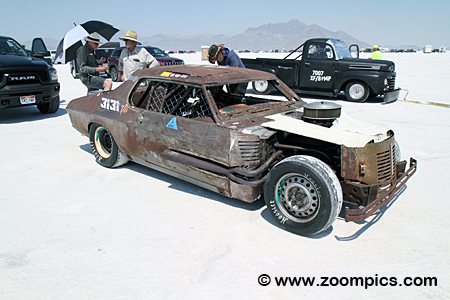
|
New Zealander Burt Monro caught the imagination of Kiwis, and plenty of his fellow citizens always entered Speed Week.
Although it is located in the same part of the world, the same cannot be said about Australians.
However, this year, dirt Late Model competitor Paul Stubber from Western Australia brought a much modified 1972 Holden Monaro to the event.
The motor was replaced with a 358 cu.in. RCR SBC engine and was in the Time Only (T/O) class.
|

|
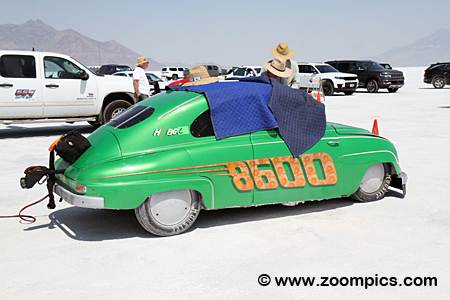
|
The Flying Pickle is a 1959 Saab 93.
Manufactured from 1955 to 1960, the Saab was powered by a 750-cc two-stroke three-cylinder engine that produced 33 horsepower.
The Flying Pickle is equipped with a 1340-cc Suzuki motor.
The Suzuki is a four-stroke, four-cylinder, sixteen-valve, double overhead camshaft engine that produces 190 horsepower.
The car was driven by Brandon Harer and its owner, Tom Kreger, who recorded a top speed of 195.980 mph.
|
|
Copyright Notice:
|
All content (photographs and text) appearing on this website are the exclusive property of © www.zoompics.com and are protected under International copyright laws. The subject matter on this website may not be reproduced, copied, stored or manipulated.
|
© Copyright 1999, 2000, 2001, 2002, 2003, 2004, 2005, 2006, 2007, 2008, 2009, 2010, 2011, 2012, 2013, 2014, 2015, 2016, 2017, 2018, 2019, 2020, 2021, 2022, 2023 and 2024
